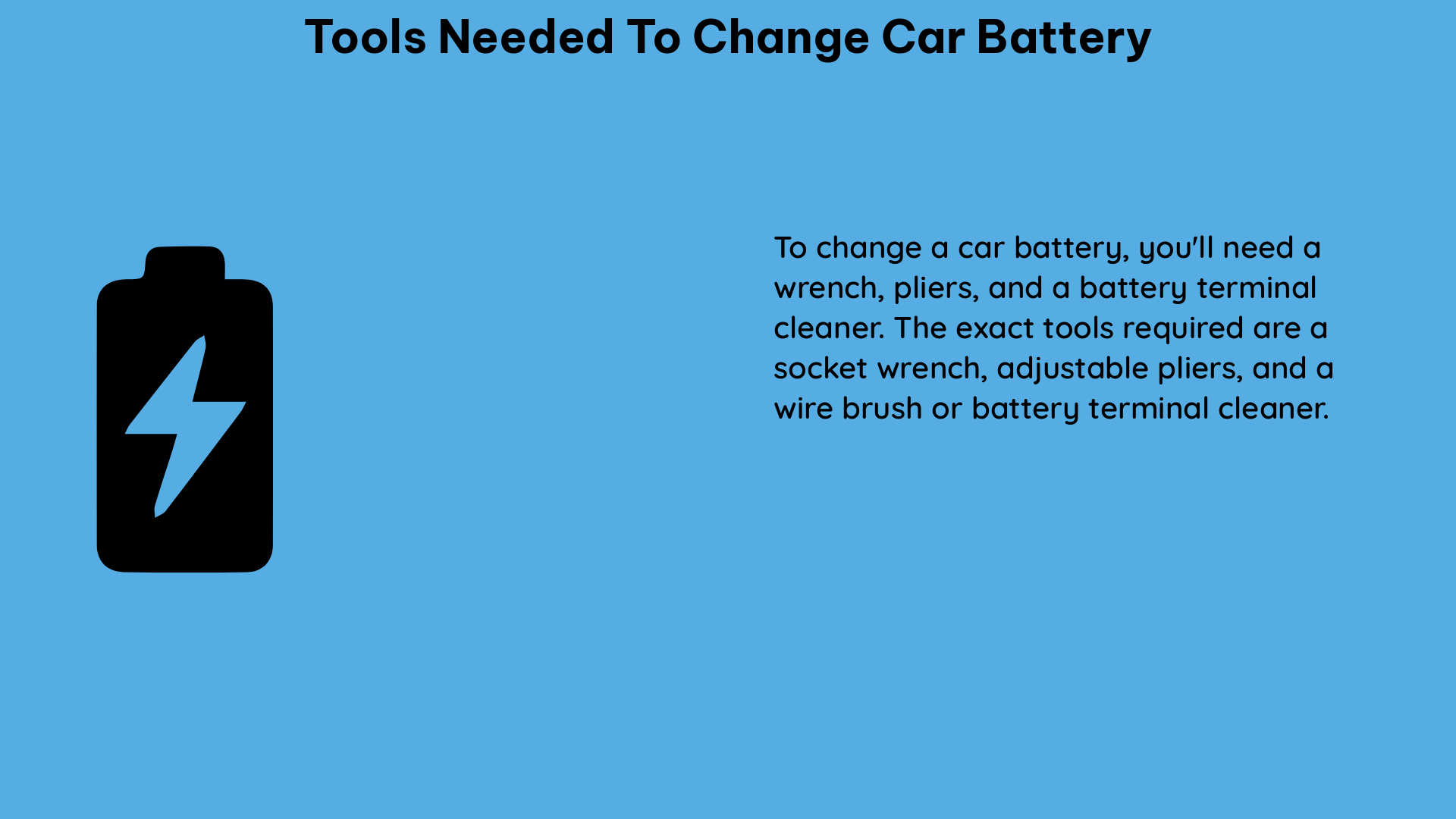When it comes to changing a car battery, having the right tools on hand is crucial for ensuring a successful and safe job. This comprehensive guide will provide you with the measurable, quantifiable data and technical specifications for the essential tools required to change a car battery effectively.
Wire Brush or Battery Terminal Cleaner
To clean the battery terminals and remove any corrosion, you’ll need either a wire brush or a battery terminal cleaner. A wire brush should have a diameter of at least 1 inch (25.4 mm) to effectively scrub the terminal posts and clamps. Alternatively, a battery terminal cleaner should have a brush diameter of at least 0.5 inches (12.7 mm) to reach into the tight spaces and remove stubborn deposits.
Crescent Wrench or Adjustable Wrench

Loosening and tightening the nuts and bolts that hold the battery terminal cables in place requires a crescent wrench or an adjustable wrench. A crescent wrench should have a jaw width of at least 1 inch (25.4 mm) to accommodate the typical size of battery terminal hardware. An adjustable wrench should have a jaw width of at least 0.5 inches (12.7 mm) to provide the necessary grip and leverage.
Socket Wrench
A socket wrench is essential for removing the hold-down clamp that secures the battery in place. The socket size required will depend on the size of the bolts on the hold-down clamp, but most battery terminals will come with either 10 mm (0.39 inches) or 12 mm (0.47 inches) socket sizes.
Adjustable Pliers
Adjustable pliers are used to hold the bolt head in place while loosening the nut with a wrench. The jaw width of the pliers should be adjustable to fit the size of the bolt head, typically ranging from 0.5 inches (12.7 mm) to 1 inch (25.4 mm).
Hammer
A hammer is a useful tool for gently tapping the terminal cable to help loosen it from the terminal post if it is stuck. A standard claw hammer with a head weight of around 16 ounces (454 grams) is typically sufficient for this task.
Battery Terminal Cleaner
A battery terminal cleaner is a specialized tool designed to brush away corrosion from the terminal posts and the end clamp of the cables. It also primes the posts of your new battery for a better connection to the terminal cables. Look for a cleaner with a brush diameter of at least 0.5 inches (12.7 mm) for optimal performance.
Corrosion Protector
Corrosion protector is a spray-on solution that helps prevent the buildup of corrosive sulfates on the battery terminals in the future. This product can extend the life of your new battery and maintain a strong connection.
Sturdy Gloves and Safety Goggles
Personal protective equipment, such as sturdy gloves and safety goggles, are essential for protecting your hands and eyes while changing a car battery. Choose gloves with a minimum thickness of 0.5 millimeters (0.02 inches) to provide adequate protection, and safety goggles with a minimum impact rating of ANSI Z87.1.
Socket Set and Ratchet
A socket set and ratchet are used to loosen and tighten the fasteners on the negative and positive cable connections. The socket sizes required will depend on the specific make and model of your vehicle, but a set with a range of 10 mm (0.39 inches) to 14 mm (0.55 inches) sockets should cover most applications.
External Power Supply
An external power supply, such as a battery charger or jump starter, is used to prevent the radio code from being needed when replacing the battery. This device helps maintain power to the vehicle’s electrical system during the battery change process.
Soap and Water
Soap and water are used to clean the battery tray area if it is excessively dirty or rusty. This helps ensure a clean and secure installation for the new battery.
Oil Spray Rust Coating
An oil-based rust coating spray can be applied to the battery tray area to protect it from future corrosion and rust buildup.
Rags
Rags are essential for wiping up any spills or mess that may occur during the battery change process.
Plastic Container
A plastic container is a convenient way to organize and store all the tools needed for the battery change, keeping them easily accessible and preventing them from getting lost or misplaced.
Memory Saver
A memory saver is a device that plugs into a car’s OBD-II port or lighter outlet to store digital information, such as radio presets and other settings, that typically disappears when a battery is disconnected. This is particularly useful for modern cars that rely heavily on computer-controlled systems.
By having these essential tools on hand, you can ensure a successful and safe car battery change, while also protecting your vehicle’s electrical system and maintaining its overall performance.
References:
– How to Change a Car Battery
– Instructables: How to Change a Car Battery
– YouTube: How to Change a Car Battery
– NAPA Know-How: Tools Needed to Change a Car Battery
– YouTube: Tools Needed to Change a Car Battery

The lambdageeks.com Core SME Team is a group of experienced subject matter experts from diverse scientific and technical fields including Physics, Chemistry, Technology,Electronics & Electrical Engineering, Automotive, Mechanical Engineering. Our team collaborates to create high-quality, well-researched articles on a wide range of science and technology topics for the lambdageeks.com website.
All Our Senior SME are having more than 7 Years of experience in the respective fields . They are either Working Industry Professionals or assocaited With different Universities. Refer Our Authors Page to get to know About our Core SMEs.